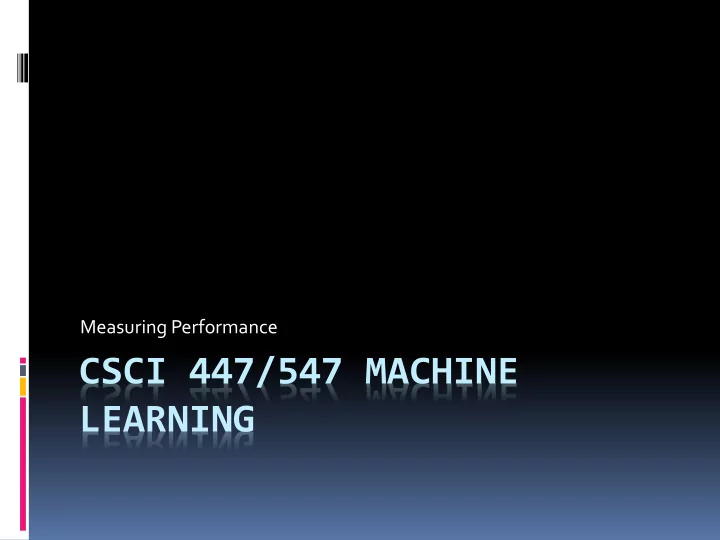

Measuring Performance CSCI 447/547 MACHINE LEARNING
Outline Confusion Matrix F1 Score Gain and Lift Charts Kolmogorov Smirnov Chart ROC / AUC Regression Metrics Kappa Statistic
Confusion Matrix Confusion Matrix Actual Positive Negative Predict Positive a b Precision a/(a+b) Negative Predictive Negative c d d/(d+c) Value Sensitivity / Recall Specificity Accuracy = (a+d)/(a+b+c+d) a/(a+c) d/(d+b) Confusion Matrix Actual 1 0 Predict 1 3,384 639 Precision 85.7% Negative Predictive 0 16 951 98.3% Value Sensitivity / Recall Specificity Accuracy = 88% 99.6% 59.8%
F1 Score Good F1 score means you have low false positives and low false negatives F1 = 2*(Precision * Recall)/(Precision + Recall) Ranges from 0 to 1 Higher values are better
Gain and Lift Charts Calculate probability for each observation Sort in descending order Split into 10 partitions (deciles) Calculate correct predictions for each partition
Kolomogorov Smirnov Chart Measure of the degree of separation between positive and negative distributions
ROC / AUC Curves Advantage over lift charts is that ROC is (almost) independent of the (possibly fluctuating) accuracy rate Measures model’s ability to discriminate between positive and negative classes
Regression Metrics Mean Absolute Error Gives an idea of magnitude of error but not direction Mean Squared Error (MSE) Root Mean Squared Error (RMSE) Converts MSE back to original magnitude R 2 (and Adjusted R 2 ) Indication of correlation of predictions to actual values Range between 0 and 1 with higher being better
Logarithmic Loss (Logloss) Evaluating the predictions of probabilities of membership in a given class Smaller is better, 0 is perfect
Kappa Statistic Cohen’s Kappa How much better than chance a model is Range is -1 to 1, with higher being better Some advise against using this Dependent on distribution of correct and incorrect predictions, Cohen’s Kappa can be misleading Power’s Kappa ( Informedness) Likelihood of making an informed decision over a random guess Recall + TNR – 1 Range is -1 to 1 1: model is always correct; 0: model is random; -1: model is always incorrect
Summary Confusion Matrix F1 Score Gain and Lift Charts Kolmogorov Smirnov Chart ROC / AUC Regression Metrics Kappa Statistic
Recommend
More recommend